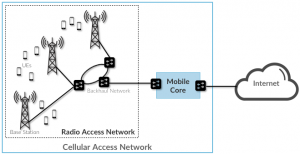Arsitektur 5G: Komponen Utama
The cellular network provides wireless connectivity to devices that are on the move. These devices, which are known as User Equipment (UE), have traditionally corresponded to smartphones and tablets, but will increasingly include cars, drones, industrial and agricultural machines, robots, home appliances, medical devices, and so on.
As shown in Figure 6, the cellular network consists of two main subsystems: the Radio Access Network (RAN) and the Mobile Core. The RAN manages the radio spectrum, making sure it is used efficiently and meets the quality-of-service requirements of every user. It corresponds to a distributed collection of base stations. As noted above, in 4G these are (somewhat cryptically) named eNodeB (or eNB), which is short for evolved Node B. In 5G they are known as gNB. (The g stands for “next Generation”.)
The Mobile Core is a bundle of functionality (as opposed to a device) that serves several purposes.
- Provides Internet (IP) connectivity for both data and voice services.
- Ensures this connectivity fulfills the promised QoS requirements.
- Tracks user mobility to ensure uninterrupted service.
- Tracks subscriber usage for billing and charging.
Note that Mobile Core is another example of a generic term. In 4G this is called the Evolved Packet Core (EPC) and in 5G it is called the Next Generation Core (NG-Core).
Even though the word “Core” is in its name, from an Internet perspective, the Mobile Core is still part of the access network, effectively providing a bridge between the RAN in some geographic area and the greater IP-based Internet. 3GPP provides significant flexibility in how the Mobile Core is geographically deployed, but for our purposes, assuming each instantiation of the Mobile Core serves a metropolitan area is a good working model. The corresponding RAN would then span several dozens (or even hundreds) of cell towers.
Taking a closer look at Figure 6, we see that a Backhaul Network interconnects the base stations that implement the RAN with the Mobile Core. This network is typically wired, may or may not have the ring topology shown in the Figure, and is often constructed from commodity components found elsewhere in the Internet. For example, the Passive Optical Network (PON) that implements Fiber-to-the-Home is a prime candidate for implementing the RAN backhaul. The backhaul network is obviously a necessary part of the RAN, but it is an implementation choice and not prescribed by the 3GPP standard.
Although 3GPP specifies all the elements that implement the RAN and Mobile Core in an open standard—including sub-layers we have not yet introduced—network operators have historically bought proprietary implementations of each subsystem from a single vendor. This lack of an open source implementation contributes to the perceived “opaqueness” of the cellular network in general, and the RAN in particular. And while it is true that an eNodeB implementation does contain sophisticated algorithms for scheduling transmission on the radio spectrum—algorithms that are considered valuable intellectual property of the equipment vendors—there is significant opportunity to open and disaggregate both the RAN and the Mobile Core. The following two sections describe each, in turn.
Before getting to those details, Figure 7 redraws components from Figure 6 to highlight two important distinctions. The first is that a base station has an analog component (depicted by an antenna) and a digital component (depicted by a processor pair). The second is that the Mobile Core is partitioned into a Control Plane and User Plane, which is similar to the control/data plane split that someone familiar with the Internet would recognize. (3GPP also recently introduced a corresponding acronym—CUPS, Control and User Plane Separation—to denote this idea.) The importance of these two distinctions will become clear in the following discussion.
_images/Slide02.png Figure 7. Mobile Core divided into a Control Plan and a User Plane, an architectural feature known as CUPS: Control and User Plane Separation
